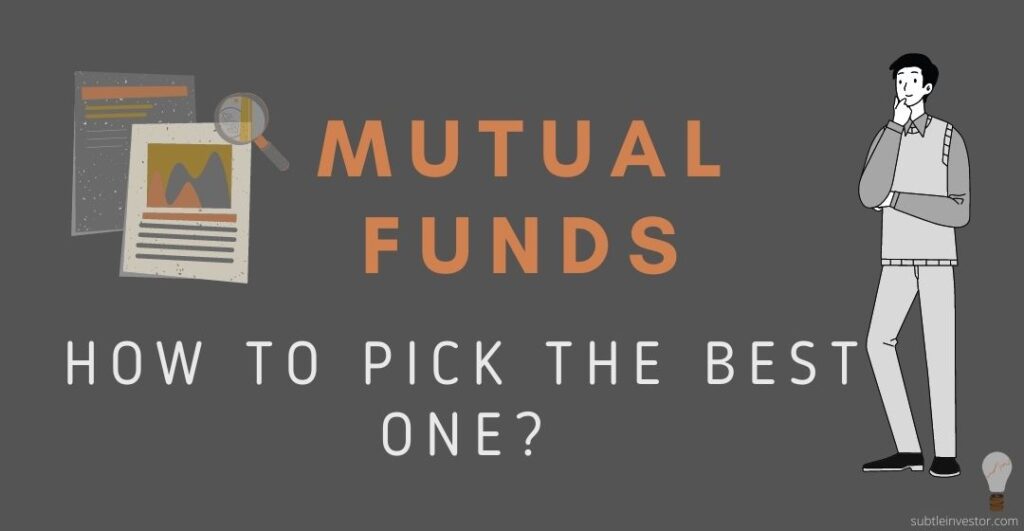How to select mutual funds for investment?
A mutual fund pools money from multiple investors into a ‘pot’ and invests them in various stocks, shares and bonds. Mutual funds are expertly manged by Fund Managers and clearly sets out what the fund aims to achieve with the pool of investor money. Investing in a mutual fund is a fantastic way of getting exposure to the stock market without directly buying a stock or share. It is even better for bond/credit exposure as it is rather difficult to directly invest in a company’s debt. Besides, it allows investors to start investing with little amount of money while gaining maximum amount of diversification benefit.
First decisions before selecting a mutual fund
With thousands of mutual funds out there how do you pick the right one? Before getting into it, an investor should first decide between the following choice:
- Equity or fixed income? Equities are relatively riskier but has higher potential for growth. Fixed income fund can provide stable income with limited downside compared to equity. [Read about my last post on all about bonds]
- Active or Passive? Both have their benefits. Active funds are best for gaining niche exposure through a skilled fund manager. Passive funds are best suited in gaining an overall market exposure with less cost
- Developed market exposure or emerging? Emerging market equities generally have higher risk and higher return characteristics compared to developed market stocks.
- Income or growth? If an investor’s primary purpose of investing is to increase the total value of their investment, then a growth style equity fund is best. However, if the aim is to generate frequent income, then an Income Equity fund or a Fixed Income (i.e. bond) fund would be preferable.

Example: Aberdeen Standard Investment's World Equity Fund
Once the above is decided, it is time to pick a mutual fund. As an example, this post will use Aberdeen Standard Investment’s (ASI) World Equity fund to analyse meaning behind the numbers and investment jargons used when describing a mutual fund.
ASI’s World Equity Fund is a mutual fund that is:
- An equity fund;
- Is actively managed;
- Has world market equity exposure (i.e. both developed and emerging);
- Is a total return fund which aims for capital growth and beating the market (i.e. not an income fund)
ASI’s website lists items such as Key Investor’s Document (KIID) and Monthly Factsheet about all the funds that they manage. Before picking a fund, it is crucial to always read these two documents.
Note that different fund management companies will have different designs in their KID; however overall type of information supplied should be similar.
ASI World Equity Fund Example KIID
ASI World Equity Fund Example Factsheet
Analysing KIID to select a mutual fund
Investment objective
This is formed of a line or two informing the investor what the fund sets out to do. This typically mentions beating the benchmark, or a specific percentage target on beating the benchmark. In this example, it aims to return the investor higher performance than MSCI AC World Index (in USD terms) before charges.
Note two important points:
(a) it will be compared in USD as the fund is managed in USD. Therefore, if you are investing money in GBP (i.e. GBP share class), then be aware of exchange rate differences in absolute performance of the fund.
(b) it aims to outperform before charges, not after charges, therefore its important to be mindful of the charge. If the fund has a high charge, then the investor’s share of any outperformance would be significantly reduced.
Inception date of the fund and the fund manager
If a fund is newly launched with a new fund manager then it is harder to anticipate the investment style of the fund or judge how the manager performed in the past. Although past performance is never a guide to future performance, it is still important to see.
Charges
5%, this fund is charging their customers an initial 5% fee on their investment. It is a one-off fee, but still quite big. There are plenty of good funds available with zero entry charges; therefore, it is a good idea to avoid funds that has such charges
0%, there is no fee to pay if the investor decides to withdraw money from this fund. Look out as some funds may have these charges
This fund does not have any performance fees; however, some funds may have. Performance fees are generally taken from a fund’s active performance (portfolio performance minus benchmark performance) if the fund manager beats the benchmark by a certain figure. For example, a fund may add a 10% performance fee on any outperformance above 3%, if the fund beats the benchmark by more than 3%.
Every fund would quote a number for this. This is the main cost of investing as it is paid to the fund management company for their expertise and administration. With recent increase in passive funds, these fees have come under a lot of pressure. The example fund by ASI charges 1.69% OCF per year. For example, if this fund performed well and beat its benchmark by 2%, then the investor would only get 0.31% active performance from their investment (and not the 2%). Therefore, smaller the OCF the better.
These fees are of course not included in the example KIID as they are paid to a platform from where an investor may decide to invest in this fund. Investors face the choice of directly investing in a mutual fund through the fund manager (i.e. ASI) or through a platform (i.e. Hargreaves Lansdown). An investor may choose to invest with a platform rather than directly from a fund manager as it enables them to invest with various fund managers from one place which ultimately can also help keep their investments all in one place.
Past performance
As mentioned, past performance is not a guide to future performance; however, it is a good gauge on the fund manager’s skill. Look out for how the fund performed when the market (i.e. benchmark) was down vs when it was up. Does the fund typically outperform during a down market? i.e. loses less money than the benchmark when the market crashes? It is also good to realise that only looking at short term performance, i.e. one year, might be rather deceiving because a great single year performance could be due to market lead (or luck) rather than the manager’s skill. As fund managers are also human, it is statistically less likely for them to continue to beat the market year on year by a meaningful number – therefore a big active performance last year might actually mean they may not be able to re-do the same performance in the following year (which is more consequential for a new investor).
Share class
Mutual funds typical have multiple share classes available to investors (with varying fees). For an individual investor, the most common being: Accumulative vs Income share class. It is important to pick and invest in the correct share class as it has an impact on future investment growth and expected income from the fund. An accumulative share class is for investors who wants to grow their capital as the investment would accumulate all the dividend income from the underlying shares and reinvest them back into the fund; while income share class would pay all the generated income back to the investor.
Analysing the Fund Factsheet to select a mutual fund
Fund size
this highlight what is the total pool of money that the fund manager manages for the fund. It becomes an important factor when the fund in question is an Emerging Market or a Small Cap Fund. Since these fund types are typically less liquid (i.e. their shares trade less) a larger fund size might be a sign of future concern for an investor when they decide to take their money out.
No. of holding
this shows how many company-shares the fund invests in. This is a good gauge on how actively the fund is managed against the market. In the example, the fund only has 40+ stocks in the portfolio against a large benchmark which highlights that the fund manager is staying active and carefully picking stocks for the portfolio. If an active fund which aims to primarily beat a global benchmark has more than 100 stocks in their portfolio, it could signal that the fund manager is in fact being too passive while charging a higher fee as an active manager. On the other hand, for an income equity fund, a 100 stocks portfolio is normal while a 30 stocks portfolio might not be (due to lack of income diversification)
Fund historic yield
this figure tells how much annual income (as % of money invested) can be expected from investing in the fund. A growth fund or a fund that aims to primarily beat a benchmark is likely to have a lower yield, such as 0.2% in this example. However, an income fund or those that primarily aims to pay a dividend to their investors would offer a yield of min 2%+ (depending on the fund)
Risk stats
A fund with beta of 1 means it would generally perform in line with the market. Beta below 1 is known as “defensive”, i.e. fund is expected to perform better (relatively) when the market is down, while beta above 1 means, the fund is rather “bullish” or aggressive against the market and expect to outperform the market when the market is up.
Mathematically this is a simple standard deviation of the fund’s past return. Lower the number, less volatile was its past performance
This number highlights how well an active fund has performed compared to the risk it took with the investor money. A positive number is of course ideal, and a number above +0.33 is deemed to be a good indicator of the fund manager’s skill
Like fund volatility, this figure measures volatility of the fund’s active performance (portfolio return minus benchmark return). Higher the number, different the fund is compared to its benchmark. An active fund is expected to have higher tracking error, at least around 3%+ during normal market conditions.
What does it all tell us about selecting a mutual fund?
…we are all different and our individual needs will not be the same. Therefore, a single mutual fund will not suit everyone based on their risk appetite and investment needs. It is best to understand one’s requirement before jumping into investing in a mutual fund.
The summary: ask yourself while selecting a mutual fund
- Do you need a regular income, or you have time and appetite to take more risk to growing the initial investment?
- Do you have a specific investment requirement or belief? i.e. is there a need to diversify your current investment by getting exposure to a niche fund? If so, an active fund that meets your requirement might be better suited than a passive equity fund
- How much fees are you paying for the investment? Is your platform fee too high? Does your current investment have an exit charge?
- Can your active mutual fund performance justify its higher fees? Is your active mutual fund, truly active?


